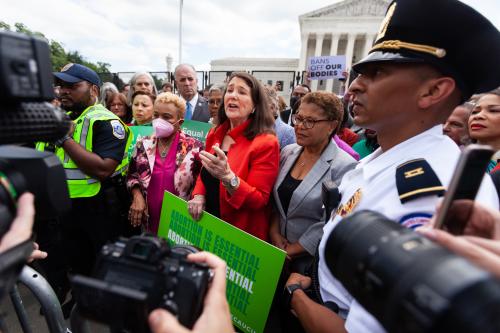On June 24, 2022, the Supreme Court of the United States ruled on one of the most controversial issues in the last 50 years. It overturned Roe v. Wade, the decision that made abortion legal in the United States. Thirty-seven percent of the population rejoiced arguing that all children have a right to life. Will those same voices rise to create policy supporting children and families as they grow?
In 2019, the last year that the CDC reported abortion numbers, 629,898 women had legal and medical abortions. The Guttmacher Institute reports 14.4 abortions per 1,000 pregnancies of women 15 to 44 years of age, with the CDC numbers suggesting that 85 percent of the women who had abortions were unmarried, 38 percent were Black, 31 percent white, and 21 percent Hispanic. Forty-nine percent of women who have abortions live on incomes that are below the poverty line.
If we really care about children and families, we have a moral obligation at the state and national levels to act now. Three years is but a second in the life of a child.
A nation that aims to protect the life of its young should undoubtedly also care about protecting the influx of babies as they develop into toddlerhood, preschool, school-age, and beyond. Yet, few in the nation are taking the long-range view of a post-Roe world. This must become a national priority.
The need for social infrastructure and the right to a full and productive life
In the U.S. in 2020, 8.4 million children needed child care. A survey of 25 states found that 27 percent of the children who needed child care could not obtain a slot, meaning that as a nation, we were 2.3 million spaces short of what was required to ensure that children were well cared for when parents—especially women—returned to work.
If birth rates remain stable in the country, in just three years in a post-Roe country, the U.S. could be short 2,897,898 spaces for early child care. Put another way, if the birth rates remain stable, 31 percent of families would not have the kind of support for their children’s care that they require. This shortage will fall disproportionately on families of color and on those who live beneath the poverty line, making it even more unlikely that underserved families will be able to escape a cycle of poverty without strong governmental intervention.
The arguments that surfaced in the Roe debates centered narrowly on the “right to life,” but little attention was given to how we support families after the birth of the baby—little attention has been given to the “right to living” a full and productive life. It is our moral obligation to address that gap.
A commitment to a “right to living” will necessitate attention to the social infrastructure needed to offer high-quality child care. High-quality child care is critical for two reasons: 1) It offers a haven for mothers who want to or need to work, and 2) it offers a way to enrich children’s experiences in ways that can last for a lifetime.
Designing optimal policies for children’s development
The emphasis on high-quality care is central, as custodial care does not reap the benefits enjoyed by those who attend cognitively and socially stimulating early care. To date, the U.S. lags behind other industrialized countries in supporting high-quality programs. By way of example, in 2017, the United States ranked 30th out of 33 member nations of the Organization for Economic Cooperation and Development in public spending on families and children, which includes policies such as child payments and allowances, parental leave benefits, and child care support.
Part of the high-quality equation also demands that child care workers be paid a living wage. The most recent data suggests that on average, child care workers earned $11.00/hour on a list of professions from the U.S. Bureau of Labor Statistics, ranking right between laundry and dry-cleaning workers and parking lot attendants. It is no surprise then that in the two years since the pandemic started, child care workers fled the field for better paying alternatives. The latest statistics suggest that real shortages remain in this sector of the economy. High-quality child care demands a high-quality workforce and funds need to be provided to ensure that child care workers who are trained to interact with the nation’s youngest citizens are fairly paid for their important jobs.
The last two years of the pandemic also underscored the strong relationship between access to high-quality care and the ability for women to enter the workforce. During COVID-19 and without adequate care, women dropped out of the workforce—a number that has not fully rebounded to this day. Without access to and availability of high-quality child care, the nation can expect increased poverty, especially among single women.
Finally, high-quality child care offers some long-term benefits to children. Studies like the small-scale Perry and Abecedarian research experiments demonstrated that high-quality child care could lead to higher levels of education, employment, and health and lower levels of incarceration as adults. These studies demonstrated that participants’ lives could be changed with responsive, supportive, and stimulating child care experiences. The larger-scale Infant Health and Development Program noted similar benefits when combined with home visiting. These programs stressed high-quality language interactions (back and forth conversations, shared book readings, and rich vocabulary), nutrition (prenatal and beyond), and healthy parenting strategies (feeding and sleeping routines, strategies to deal with misbehavior, and so on). A large and comprehensive study of early child care, the National Institute of Child Health and Human Development study of early care, found that high-quality child care starting in infancy is linked to higher children’s outcomes on math and reading tests that persisted until age 15, and higher levels of education and employment at 26 years of age.
The seemingly contrasting data from the recent Tennessee study, Head Start evaluation, and Early Learning Network studies help us to understand that when preschool programs are not properly scaled, children will not enjoy these longer-term benefits. For example, many of these studies show that the learning experienced by children in these settings was predominantly marked by large group activities with passive children learning in teacher-led instruction. Evaluation of the North Carolina pre-K program found that time spent in large group activities was the largest negative predictor of gains in important skills such as language, math, and gains in attention, memory, and impulse control. It is thus no wonder that this well-designed study showed that at scale, we need more than custodial approaches to child care. Well trained teachers who use a whole-child, active playful-learning approach will also need to be well paid for their expertise.
The bottom line is that those who study the science of child development can work with policy experts to create optimal environments for children in a post-Roe world; to provide not only for the birth of the infant, but for a “right to living” a full and productive life. Three years from now, when the influx of new babies become preschoolers, we as a nation of concerned citizens must decide how we will treat them and what we will do to support their parents. Will we start to build the infrastructure that will prepare our children to thrive or will we let these children wallow in poverty?
If we really care about children and families, we have a moral obligation at the state and national levels to act now. Three years is but a second in the life of a child.
The Brookings Institution is committed to quality, independence, and impact.
We are supported by a diverse array of funders. In line with our values and policies, each Brookings publication represents the sole views of its author(s).










Commentary
Supporting children post-Roe: An urgent call for social infrastructure
July 19, 2022